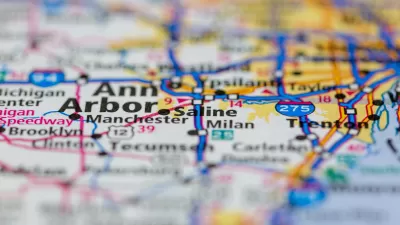States are developing a variety of mechanisms for replacing dwindling gas tax revenue, which most rely on for the majority of their transportation funding.

More states are implementing policies aimed at replacing lost revenue from gas taxes, which are bringing in less money as more electric vehicles hit the road and have “traditionally been a critical source of funding for transportation infrastructure,” according to an article by Jared Brey in Governing.
Brey notes that “A national pilot program to collect VMT fees in place of gas taxes is expected in the next few years.” Meanwhile, over half of U.S. states have some kind of fee for electric vehicles to offset the lost revenue, but a recent report from the MIT Mobility Initiative reveals that “most aren’t high enough to replace the revenue the average driver pays in state gas taxes each year.”
“The need to replace the gas tax is also a chance to build a ‘more rational transportation funding system,’ the report says — one that accounts for all the ways that cars wear on infrastructure and the environment, whether they’re electric or gas-powered.” In 2006, Oregon launched the nation’s first voluntary VMT-based fee program, which “allows drivers to opt in and pay a 1.8-cents-per-mile fee and get a credit against gas taxes paid.”
At the federal level, the Department of Transportation is tasked by the Infrastructure Investment and Jobs Act with developing a pilot program to “test the design, acceptance, implementation and financial sustainability” of VMT fees, but Garett Shrode, a policy analyst at the Eno Center for Transportation, says the department is “dragging its feet” and “should focus on simplicity, and on finding ways for federal and state VMT programs to overlap.”
FULL STORY: Clock Ticking for States to Replace Dwindling Gas Taxes

Alabama: Trump Terminates Settlements for Black Communities Harmed By Raw Sewage
Trump deemed the landmark civil rights agreement “illegal DEI and environmental justice policy.”

Planetizen Federal Action Tracker
A weekly monitor of how Trump’s orders and actions are impacting planners and planning in America.

How Atlanta Built 7,000 Housing Units in 3 Years
The city’s comprehensive, neighborhood-focused housing strategy focuses on identifying properties and land that can be repurposed for housing and encouraging development in underserved neighborhoods.

In Both Crashes and Crime, Public Transportation is Far Safer than Driving
Contrary to popular assumptions, public transportation has far lower crash and crime rates than automobile travel. For safer communities, improve and encourage transit travel.

Report: Zoning Reforms Should Complement Nashville’s Ambitious Transit Plan
Without reform, restrictive zoning codes will limit the impact of the city’s planned transit expansion and could exclude some of the residents who depend on transit the most.

Judge Orders Release of Frozen IRA, IIJA Funding
The decision is a victory for environmental groups who charged that freezing funds for critical infrastructure and disaster response programs caused “real and irreparable harm” to communities.
Urban Design for Planners 1: Software Tools
This six-course series explores essential urban design concepts using open source software and equips planners with the tools they need to participate fully in the urban design process.
Planning for Universal Design
Learn the tools for implementing Universal Design in planning regulations.
Caltrans
Smith Gee Studio
Institute for Housing and Urban Development Studies (IHS)
City of Grandview
Harvard GSD Executive Education
Toledo-Lucas County Plan Commissions
Salt Lake City
NYU Wagner Graduate School of Public Service





























